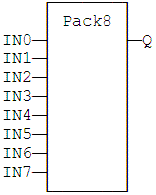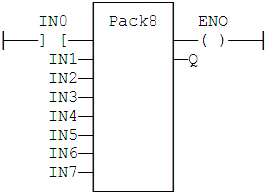![]()
 Function
Function![]() A function calculates a result according to the current value of its inputs. A function has no internal data and is not linked to declared instances. - Pack bits in a byte.
A function calculates a result according to the current value of its inputs. A function has no internal data and is not linked to declared instances. - Pack bits in a byte.
Inputs
|
Input |
Data Type |
Range |
Unit |
Default |
Description |
|---|---|---|---|---|---|
|
IN0 |
BOOL |
|
|
|
Less significant bit. |
|
IN7 |
BOOL |
|
|
|
Highest significant bit. |
Outputs
|
Output |
Data Type |
Range |
Unit |
Description |
|---|---|---|---|---|
|
Q |
USINT |
|
|
Byte built with input bits. |
Remarks
None
FBD Language Example
FFLD Language Example
- The input rung is the IN0 input.
- The output rung (ENO) keeps the same value as the input rung.
- ENO keeps the same value as EN.
IL Language Example
- In the IL
 "Instruction List"
This is a low-level language and resembles assembly Language, the input must be loaded in the current result before calling the function.
"Instruction List"
This is a low-level language and resembles assembly Language, the input must be loaded in the current result before calling the function.
Op1: LD"Ladder diagram" Ladder logic is a method of drawing electrical logic schematics. It is now a very popular graphical language for programming Programmable Logic Controllers (PLCs). It was originally invented to describe logic made from relays. The name is based on the observation that programs in this language resemble ladders, with two vertical "rails" and a series of horizontal "rungs" between them IN0
PACK8 IN1, IN2, IN3, IN4, IN5, IN6, IN7
ST Q
ST Language Example
Q := PACK8 (IN0, IN1, IN2, IN3, IN4, IN5, IN6, IN7);
See Also








